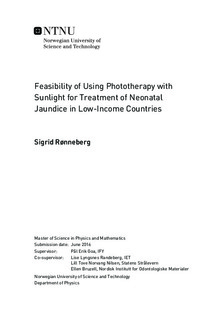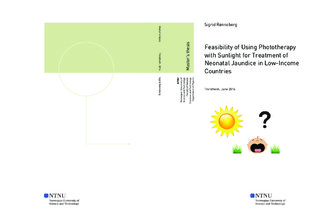| dc.description.abstract | This thesis aimed to investigate the feasibility of using sunlight exposure as treatment for neonatal jaundice in low-income countries. The investigation answered four questions:
1. Is it feasible to treat infants with neonatal jaundice with sunlight?
2. Are the existing treatment guidelines sufficient for all skin types?
3. Is sunlight treatment adequately efficient compared to conventional treatment?
4. Is sunlight treatment of neonatal jaundice feasible in the investigated locations?
More than 114 000 infants die annually due to untreated neonatal jaundice worldwide, and a large percentage of these deaths occur in sub-Saharan Africa or South-East Asia. These areas are locations with abundant sunlight.
The methods used in this thesis included irradiance measurements of conventional phototherapy equipment and an assessment of treatment conditions at a representative hospital in Norway. In addition, atmospheric simulations with libRadtran were performed with satellite overpass data from 2015 for Dar es Salaam, Kathmandu and Østerås, with the latter as a reference location. Further, simulations of fluence in skin of melanin pigmentation corresponding to skin types II, IV, V and VI were performed by using a Monte Carlo method for multi-layered tissue. Skin type II was chosen for reference, and the higher skin types were included due to the relevance in sub-Saharan Africa and South-East Asia.
The average bilirubin weighted total irradiance of the conventional phototherapy units at St. Olavs Hospital was 10.3 W/m 2 , which was just within the scientific recommendations of at least 10 W/m 2 of irradiance for maximal effect of the phototherapy. The solar irradiance was of the same magnitude for all the chosen locations, and the maximal value at noon ranged with the seasons and atmospheric conditions from 0.8 − 7.3 W/m 2 for Dar es Salaam, 0.7 − 6.7 W/m 2 for Kathmandu and 0.1 − 5.4 W/m 2 for Østerås. The simulated fluence at a skin depth of 295 μm was reduced to 43% of the fluence for skin type II in skin type VI, which showed a great impact of pigmentation on the fluence in the skin.
The bilirubin weighted radiant exposure achieved through conventional phototherapy in Norway was 7.42*10^5 J/m². To achieve the same effective radiant exposure through exposure to sunlight, the exposure times for average summer days with sunlight exposure from sunrise to sunset was 4.3 days in Dar es Salaam, 4.2 days for Kathmandu and 5.4 days for Østerås. In winter, these exposure times increased with 35%, 88% and 234% for the three locations, respectively. For skin type VI, the summer exposure time became 10.2 days, 10.0 days and 13.0 days, respectively. The amount of adverse effects from erythema was severe for each day of sunlight exposure, both in painful sunburn and increased risk of skin cancer. All calculations were only indicative, as they were based on certain assumptions and uncertainties, which include uncertainties in satellite overpass data, uncertainties in both skin types and infant skin, and assumptions on the scaling of required exposure time for different skin types.
The thesis concluded that it is feasible to treat neonatal jaundice with sunlight, with reservations. These reservations are connected to the calculated exposure times, which might give substantial adverse effects of sunburn. None of the existing treatment guidelines are sufficient concerning skin types of different pigmentation. If sunlight treatment is used optimally and the guidelines for conventional phototherapy are optimised, the sunlight treatment might be as efficient as conventional treatment in treating neonatal jaundice. This relatively new treatment option might be life-saving for infants in low-income countries. | |

